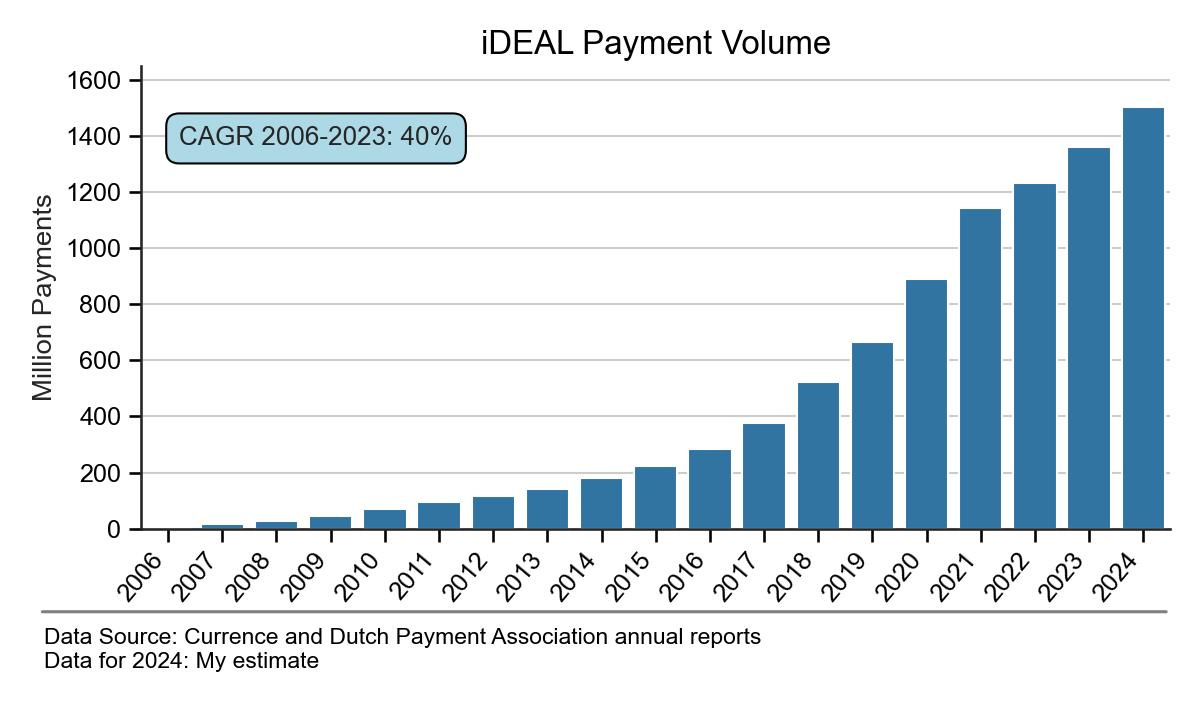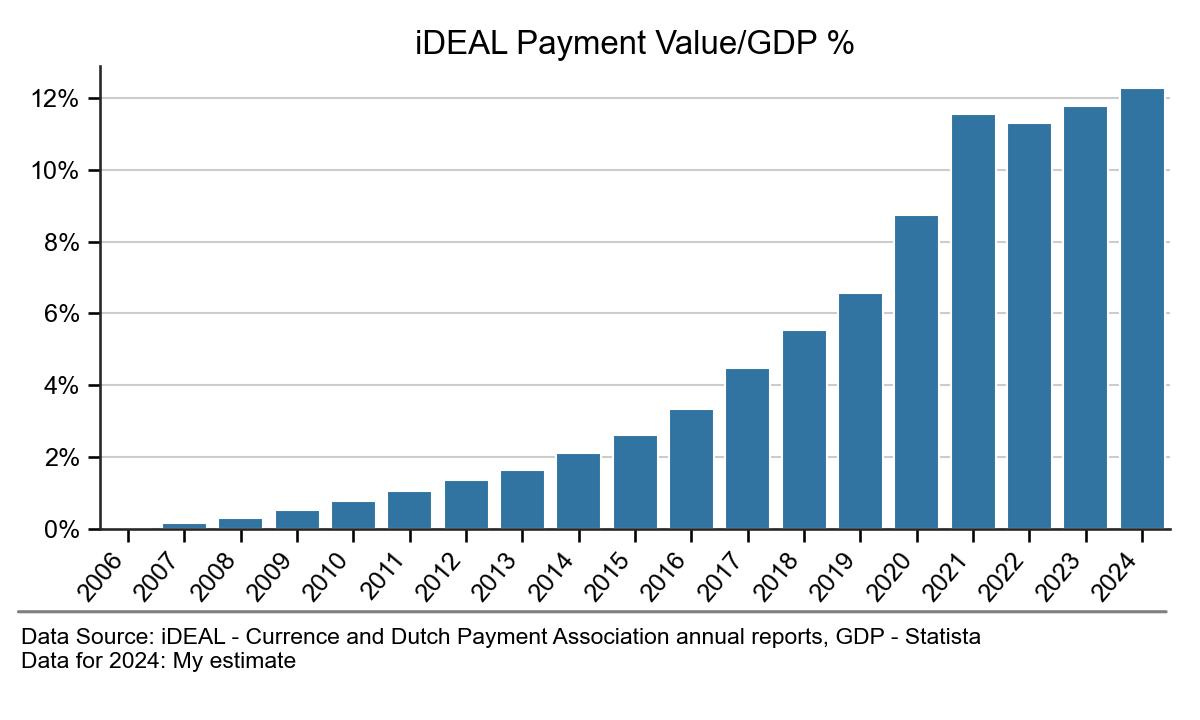How and why iDeal is a great Dutch and payments success
The Ideal Payment System
Background
19 years ago this month (4th October 2005) a group of eight Dutch banks launched the iDEAL payments system for online payments.
At the time, ecommerce, a €3bn market1 was growing fast at 28% per year, but the only way to pay was by a credit card, PayPal, separate bank transfer or by in-person payment on delivery. Neither credit cards nor PayPal had a high penetration in the Netherlands and the debit card system, PIN was unusable online.
Rather than adopt Visa and Mastercard debit cards for online payments, a route taken by other countries in the same position, the Dutch decided to build their own payment system for online purchases and iDEAL was born.
Rapid Adoption
iDEAL was adopted rapidly from the start. From 4.4m payments in its first full year, 2006, to 1.36bn payments in 2023, with 1.5bn payments I estimate for 2024. Figure 1 shows how volumes have grown since launch, with a CAGR of 40% over 17 years to 2023.
Figure 1 – Growth in iDEAL payments since launch
iDEAL Uses
iDEAL is used extensively in the Netherlands for ecommerce and today accounts for 73%2 of all ecommerce payments by transaction volume (credit cards 8%, PayPal 2%3).
However, ecommerce is just one use case for iDEAL. Figure 2 shows how the value of iDEAL payments outstrips Dutch ecommerce, having overtaken it in 2015. In 2023, iDEAL accounted for 60% of ecommerce purchases by value, which I estimate to be €21bn.
The last published figure for the value of iDEAL payments that I can find is €99bn in 20214 and from this I estimate the figure for 2023 to be €122bn. Thus, in 2023, €101bn of iDEAL payments were made outside of Dutch ecommerce, roughly five times as much.
There is no breakdown of iDEAL payment values I can find except for Dutch ecommerce, but in 2015 3% of iDEAL payments by value were on non-Dutch websites (almost 25%of these were to China, 16% to Germany and 15% to Great Britain – at the time, iDEAL was available in 60 countries)5. Say that proportion has grown to 5%, then perhaps €6bn of iDEAL payments were for international ecommerce, leaving €95bn for other areas such as payment of invoices, mobile top-ups, tax and government services, public transport, donations to charity and person-to-person payments.
Figure 2 – iDEAL payments are much larger in value than Dutch ecommerce
Tikkie Payment Requests
iDEAL is also used for consumer-to-consumer payments, such as Tikkie, the hugely popular request-to-pay service provided by ABN Amro. Anyone can send a payment request using the Tikkie app, which can be paid by return by the recipient, using iDEAL. €5.5bn was paid through 130m payments for Tikkie requests in 20226, a 30% increase over 2021, so it is possible that the figure was €7bn in 2023.
The average Tikkie payment value was €42 in 2022, but they can go to as low as a few cents – for some amusing examples, go to this Reddit discussion forum.
iDEAL Features and How it Works
The customer experience using iDEAL is similar to open banking. On online checkout, the customer clicks the iDEAL option, selects their bank, logs in to their account, approves the payment and returns to the retailer website.
Unlike open banking the iDEAL platform is connected directly to the Dutch banks (14) rather than through APIs. Once an iDEAL payment is initiated, real-time confirmation is sent to the iDEAL platform by the bank and then onwards to the retailer. Settlement is through the normal Equens Worldline or Target2 interbank clearing. The retailer receives the funds either instantly or same day.
Retailers and billers need to use their (acquiring) bank, an acquirer or a PSP (collecting payment service provider) to accept iDEAL payments (through an iDEAL API or SDK provided to them). Larger retailers/billers typically use a bank or acquirer, requiring a specific iDEAL contract, smaller ones use CPSPs where no specific iDEAL contract is needed. Currently, there are 18 acquirers, 62 CPSPs7 and 210,000 retailers/billers8.
Over the years, steadily iDEAL has added new features and capabilities, including:
Initiation through mobile banking apps – more than 80% of iDEAL payments are made this way
iDEAL ID - a personalised, reusable id linked to the user's bank account for faster checkout and recurring payments
iDEAL QR – captured within a banking to initiate an iDEAL payment
iDEAL Checkout – faster checkout using saved preferences such as delivery address
iDEAL in3 – the payment is split into three equal installments, one paid immediately, one paid 30 days later, the last paid 60 days later, at no extra cost to the consumer
iDEAL Scheduling – to schedule future payments to a business e.g. subscriptions
iDEAL Payment Link – payment requests sent via email, Whatsapp etc by agreement with a biller
iDEAL C2C – for consumer-to-consumer payments such as Tikkie
Consumer Protection and Fraud
iDEAL has very low levels of fraud – no figures are published, but there are no consumer protection measures specific to iDEAL, such as chargebacks. 19 years of operation and dominance in Dutch payments are evidence that such measures have been unnecessary.
The key reason is that payments can be initiated only through strong customer authentication using banking apps and payments can be received only by vetted retailers/billers onboarded by acquirers and PSPs. They are responsible for ensuring that their retailers/billers use iDEAL for legitimate purposes.
iDEAL also shares information on suspicious actors with acquirers, CPSPs and C2C providers through the National Internet Fraud Complaints Desk. It is very difficult for scammers to slip through the net – for example, in 2014 just 19 suspicious websites were detected, 17 were fraudulent and removed from iDEAL.
Why iDEAL is Successful
The scale of iDEAL’s success can be seen in Figure 3, which compares the value of iDEAL’s payments to Dutch GDP9. From nothing in 2005 to12% today, iDEAL is a major feature of the Dutch economy.
Figure 3 – iDEAL has become a significant feature in the Dutch economy
iDEAL’s success is due to a strong product-market fit since its launch. It is available automatically to all Dutch consumers with a bank account and almost all online Dutch retailers accept iDEAL (as well as many other billers and retailers/billers outside the Netherlands).
The consumer experience is good. With ecommerce growing strongly in the early years, a low penetration of credit cards and PayPal and Dutch debit cards (PIN) unusable online, online retailers adopted iDEAL rapidly. As a result, the acceptance network for iDEAL reached critical mass quickly and strong network effects took hold.
Critically, the Dutch banks were behind iDEAL. They had no significant debit card interchange revenue streams to protect, no appetite to use Mastercard and Visa for online debit card transactions and were bold and innovative enough to design and build iDEAL instead.
iDEAL’s resilience to fraud is a key factor. It has allowed it to grow without a constant battle to contain fraud with ever-increasing costs as has happened with the card networks. Cards are inherently prone to fraud (they can be stolen and counterfeited) and the chargeback mechanism to deal with it generates its own significant first-party fraud problems. The lack of an iDEAL chargeback mechanism is considerably attractive to retailers and billers.
iDeal also has a commercial model that works well for all parties. Acquirers, CPSPs and C2C providers pay10 an entry (licence) fee, a fixed annual fee and variable transaction fees which cover the cost of operating and developing the iDEAL platform. In turn, acquirers, CPSPs and C2C providers charge their retailers and billers fees in a competitive market. These fees are typically low compared to other payment methods.
For example, Adyen11 charges online retailers no onboarding fee, a €0.11 processing fee for every transaction independent of payment method and a payment method fee of €0.22 for an iDEAL payment. Its payment method fee for Mastercard debit cards is at least 0.8% of transaction value (€0.40 on a €50 payment) and at least 0.9% for credit cards. Its American Express payment method fee is 3.95%.
As you can see, iDEAL is a good deal for retailers and billers.
The Wero Digital Wallet
A year ago, iDEAL was acquired by The European Payments Initiative (EPI)12from its previous operator Currence (owned by the Dutch banks), together with its technology provider Payconiq International (Luxembourg). EPI’s mission is to rollout a digital account-to-account real time payments wallet, the Wero13 across the Eurozone. It launched in France last month, with Germany and Belgium to be added shortly.
EPI’s plan for the Netherlands is to replace iDEAL with Wero starting in 2026 (although this could change). It is a huge sacrifice for the Dutch banks to allow this, no doubt made for the greater good of a common European payment mechanism. It is also a bold undertaking, but so was the original development of iDEAL.
Whether it proves to be an ideal move, or otherwise, time will tell.
Resilience to Fraud
iDEAL has low levels of fraud due to the strong controls over both parties in a payment.
iDEAL payments are initiated only through strong customer authentication provided by banks. It is very difficult for fraudsters to get past this by breaking through online/mobile bank controls, unlike, for example with cards which can be counterfeited, stolen or hacked to initiate a card payment.
iDEAL payments may be received only by retailers and billers who have a contract with a PSP - an acquirer or a CPSP (collecting PSP). All retailers and billers go through a know-your-business onboarding process with their PSP. This process is required by iDEAL, including measures and standards (e.g. website quality) that ensure only trusted retailers/billers are onboarded. These are screened before connecting to the network, against a risk profile (low, medium, high) and afterwards are monitored on their risk profile and their transactions. Consumers resolve any issues such as non-delivery, poor quality, over-charging, directly with a retailer/biller. Where a retailer/biller has been reported by a user and found to have acted fraudulently (e.g non-delivery of purchased items), the retailer/biller is struck off and deleted from the iDEAL system.
Originally, PSPs were responsible for monitoring retailers/billers and transactions, but this is now done centrally by iDEAL (on the iDEAL 2.0 platform). iDEAL ensures consumers are reimbursed for any fraud, paid by the respective bank (depending on the case and on the precautions the consumer has taken). Funds are recovered from the retailer/biller’s bank account. iDEAL also publishes a list of fraudulent websites and links to a police list of rogue traders.
Authorised push payment (APP) fraud is very low, perhaps non-existent on iDEAL due to the tight control over retailers/billers and their small subset of bank accounts. There are around 350,000 retailers/billers to monitor and control, as opposed to tens of millions of bank accounts.
Card networks have similar stringent requirements for onboarding retailers and billers, but fraud at scale still occurs due to unauthorised card transactions. Consumers are protected through the card chargeback mechanism, but retailers/billers are liable for each chargeback even if the fraud is outside their control, which they loathe. In contrast, with iDEAL, any fraud is traceable directly to a retailer/biller and losses can be recovered from them.
Success Factors
Stakeholders and stakeholder management – demand for iDEAL was driven by stakeholders such as web retailers. Strong stakeholder management and serving the needs of banks, PSPs and retailers is core to iDEAL and its governance.
Ecosystem harmony – there is strong cooperation by the licenced PSPs on the common infrastructure in adhering to the rules & regulations and to the scheme governance. The ecosystem is managed and regulated well as a whole, with all participants compliant with the scheme rules & regulations, overseen and checked by iDEAL’s operator (originally Currence, now EPI).
Low costs - the iDEAL scheme has been low-cost from the start, making it attractive to retailers and billers. It was built on existing technologies – the SEPA credit transfer and internet banking. The only new capability in 2005 was a new protocol connecting a retailer website to its bank to the consumer’s bank and back. No expensive and complicated infrastructure was built.
An effective fee structure - iDEAL has a relative low fee for retailers/billers compared to other online payment methods and no fee for consumers. Debit card fees in the Netherlands, including interchange, for in-person and point-of-sale payments have always been low, providing a benchmark for low fees when iDEAL was set up. iDEAL has always been priced on a fixed fee per transaction, with no ad valorem fee, reflecting the low risk of iDEAL payments.
Origins
When iDEAL launched in 2005, initially there were just three banks backing it who became the shareholders of iDEAL.
The main reason the banks built iDEAL was due to a request from the home shopping association, Thuiswinkel to build a single online payment system covering all banks. This was to replace existing systems individual banks had built, resulting in websites with separate technical payment connections to each bank. It was complex for the retailers to implement and manage multiple bank connections, no doubt the user experience was also complicated and the retailers had the inconvenience of negotiating separate contracts with each bank.
Use Cases
The last published figures showing where iDEAL is used were for 2020. That year, Dutch ecommerce accounted for 26% of all iDEAL payments by value, 14% from purchases on foreign websites, 21% form consumer-to-consumer payments and 39% from other transactions such as bill payments.
Although Tikkie is a popular consumer-to-consumer payment request app provided by ABN Amro, other Dutch banks also support consumer-to-consumer payment requests which are paid through iDEAL.
Acceptance Network
Currently, iDEAL does not use instant payments end-to-end from consumer to retailer/biller. PSPs have separate agreements with their retailers/billers covering when funds are credited to their bank account. Typically, funds are credited to the retailer/biller at the same time as those for other payment methods provided to the retailer/biller by their PSP.
Retailers/billers accepting iDEAL have a contract with their PSP to use iDEAL as a payment option rather than directly with iDEAL. Smaller retailers in general opt for a CPSP to get a package of services including a set of payment options (e.g Visa, Mastercard etc) and technical implementation services.
The most recent annual report 2022 (published in October 2023) shows 349,032 retailers offered iDEAL, split 300,318 from the Netherlands (86%), 48,714 from other countries (14%).
Comparison with Open Banking
The main difference with open banking payments is that iDEAL is a regulated open scheme adhered to by PSPs, whereas open banking is a payment initiation mechanism. Compliance with scheme rules & regulations and technical requirements is checked by the iDEAL operator (previously Currence, now the EPI).
With open banking there is no open banking scheme or operator dedicated to managing it (however, in the UK, a central body, Open Banking Ltd standardises APIs). Originally, the iDEAL platform used bilateral connections to banks using XML, the upgraded platform (iDEAL 2.0) is designed for uniform API connections with all PSPs.
Thanks Jeremy
Thank you to Jeremy Light for sharing How and why iDeal is a great Dutch and payments success as a Payments:Unpacked guest blog.
Subscribe to Jeremy’s blog at: https://substack.com/@jeremylight
Enhance your payments knowledge
1 ecommerce in the Netherlands 2005 - 2023: https://www.statista.com/statistics/558214/yearly-online-consumer-expenditure-in-the-netherlands/
2 iDEAL website: https://ideal.nl/en/online-consumentenbestedingen-nemen-toe-vooral-vanwege-run-op-vakanties
3 Dutch Payment Association annual report 2023: https://www.betaalvereniging.nl/wp-content/uploads/Jaarverslag-Betaalvereniging-Nederland-2023.pdf
4 iDEAL website: https://ideal.nl/en/online-consumentenbestedingen-nemen-toe-vooral-vanwege-run-op-vakanties
5 Currence annual report 2016: https://www.currence.nl/wp-uploads/2016/07/Cu_CurrenceJVUK2015.pdf
6 ABN Amro News 29 Dec 2022: https://www.abnamro.com/en/news/new-annual-record-tikkie-payment-volume-reached-eur5-5-billion-in-2022
7 iDEAL website: https://www.ideal.nl/en/acquirers-and-cpsps
8 iDEAL website: https://www.ideal.nl/en/about-us
9 GDP is used as a comparator only to gauge the size of the iDEAL payment system. There is no implication that iDEAL represents 12% of the Dutch economy.
10 iDEAL website, fees: https://www.ideal.nl/en/ideal-fees
11 Adyen website, pricing: https://www.adyen.com/pricing
12 iDEAL press release 31 October 2023: https://ideal.nl/en/epi-successfully-completes-acquisition-of-ideal-and-payconiq-international note - this acquisition may be why publicly available data about iDEAL has tailed off since 2022
13 Wero website: https://wero-wallet.eu/









